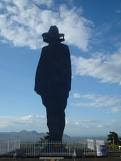Rosey Soley composed a poem dedicated to her lover, fallen in the terrible conflict between Nicaraguans. Salvador Cardenal set the words to music, and here it is presented by Salvador and Katia, as
Duo Guardabarranco. This song embodied the spirit of a generation dedicated to give their lives for the Revolution. Thank you, Rosey, Katia, and Salvador, for leaving us this beautiful homage to love and conflict in
Nicaragua. The role of testimonial music in the Nicaraguan Revolution was tremendous, as can be imagined by the imagery and words of this song.
Warrior of Love (Rosey Soley and Salvador Cardenal)
I’ll trade you a song for the courage of your young combatant hands,
Welded to the metal with which you will save us.
I’ll trade this love of life and its promises
For the cold of your feet in the swamps,
Making fear and homesickness burn you.
Anonymous author of the dawn,
Silent deer in the mountain,
Warrior of love;
Son of these times, windmill,
Manchild born in the jungle
To go until the end, to the victory
I’ll trade you those 20 years, duplicated
Because of this necessary war,
For the silvery flower of hope

Te cambio una canción por el coraje
de tus jovenes manos combatientes,
fundidas al metal con que nos salvas.
Te cambio este amar la vida y sus promesas
por el frio de tus pies entre los suampos;
fraguando que se te quema el miedo y la nostalgia.
Autor anónimo de la alborada,
venado silencioso en la montaña,
guerrero del amor
hijo de este tiempo, remolino
hombre niño parido pues en plena selva
para llegar al fin a la victoria para llegar al fin.
Te cambio esos 20 años duplicados
a causa de esta guerra necesaria,
por la carnosa flor de la esperanza.
Autor anónimo de la alborada,
venado silencioso en la montaña;
guerrero del amor,
hijo de este tiempo, remolino
hombre niño parido pues en plena selva
para llegar al fin a la victoria para llegar al fin.
Autor anónimo de la alborada,
venado silencioso en la montaña;
guerrero del amor,
hijo de este tiempo, remolino
hombre niño parido pues en plena selva
para llegar al fin a la victoria para llegar al fin.
(Canción Dedicada a "Sandino" General de Hombres Libres 1983)








































